The size-adjusted median price was down again last month for both property types, with a decline of 2.6% for single family homes and 7.8% for condos. The condo median price per square foot has now fallen over 50% from the September 2005 peak, forcing me to extend the Y axis downward in the chart below:
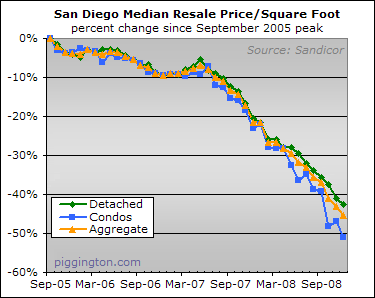
To be exact, the size-adjusted median condo price is down 51% from the peak. The single family size-adjusted median is down a mere 43%, and a volume-wighted aggregated of the two is down 45%.
The median looks pretty similar over the long haul, though the monthly noise is quite a bit worse:
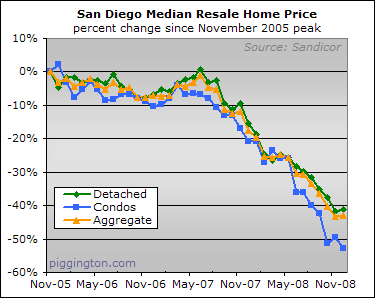
As often discussed, part of the decline in the median-based indicators is probably due to the fact that cheap properties are moving faster. So my projection of the November and December Case-Shiller index declines might end up being a bit on the pessimistic side. Nonetheless, here is a chart of same:
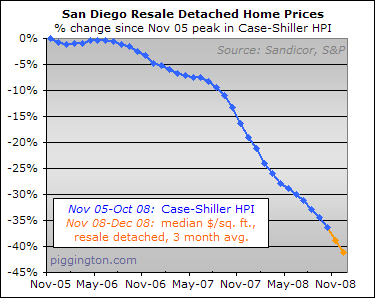
After a steep drop in November, sales volume came back. My guess would be that the drop in rates is pushing some would-be buyers off the fence and overcoming at least some of the negative effects of the market meltdown.
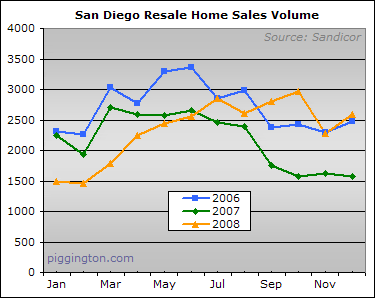
Inventory for sale continued its gentle decline…
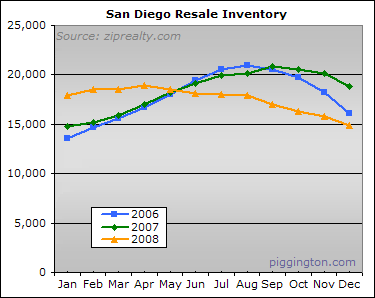
…resulting in another months-of-inventory reading below the 6 month mark. Total inventory has of course been a very poor indicator of any sort of market health, as the apparently reasonable level of overall inventory has been overshadowed by the fact so much of it consists of foreclosures and short sales.

The Fed is now officially creating money out of thin air in order to buy Agency debt and mortgage-backed securities, pushing mortgage rates down to unnaturally low levels. This is a radical act that flies in the face of what used to be considered sound central banking. I mention this just to show how desperate the government is to prop the whole edifice up. And there is a lot more intervention to coming, housing and otherwise.
Yet thanks to unemployment, foreclosures, a general move towards reasonable lending standards, and still not great valuations, the fundamentals for housing are still poor.
The clash between these two forces — poor housing fundamentals vs. cyclopean government intervention — will be a big part of what 2009 is all about.

A sobering update Rich. I
A sobering update Rich. I copy below an FT article which makes the existence of the shadow inventory more of a global story. Graham
————————
Foreclosure to the bone
By
Published: January 11 2009 18:55 | Last updated: January 12 2009 09:25
Decisions, decisions. How to spend the next $350bn? Democratic policymakers want to improve the oversight of the troubled asset relief programme and better track how recipients use government funds. They also want at least $40bn of the next tranche to be used to help struggling homeowners stave off foreclosure. With the first slug of money lodged in bank balance sheets, it is time, they argue, to spread aid around.
However well intentioned, helping homeowners is a daunting challenge. Foreclosure figures and the housing market are set to worsen. Resets loom on alt-A and option adjustable-rate mortgages, which could cause borrowers to default at similar rates to the subprime segment. State-level moves to slow foreclosures will have pushed filings from last year into this. Rising unemployment, too, is set to increase delinquency rates.
Worse still, given already sky-high supply, there is evidence that foreclosed properties are not yet fully reflected in inventory figures. RealtyTrac matched its database of bank-owned properties to agents’ listings for four states: California, Florida, Wisconsin and Maryland. Only between a quarter and 35 per cent of bank-owned properties (known as real estate-owned, or REO) showed up in the listings, suggesting that banks hold a sizeable “shadow inventory” of foreclosed homes. Adding back that missing portion of RealtyTrac’s 900,000-odd total of REO homes would increase official inventory figures based on listings by about 15 per cent. Such an overhang of minimally maintained properties would further depress prices.
Citigroup’s endorsement last week of bankruptcy reform, enabling judges to restructure mortgage debts – previously the industry’s bête noire – shows new willingness for drastic solutions. But such measures could come at the cost of added uncertainty and higher interest rates. Loan modification, meanwhile, remains tricky as shown by the limited uptake of existing programmes and high rates of re-default. There is no easy answer to mortgage misery.’
Thanks Rich. We’ll get to see
Thanks Rich. We’ll get to see just how influential govt intervention can be in a market. As I think they’re going to try every trick imaginable to put a floor in the market.
I still would like to see yearly inventory reports from the early 1990’s until now. I think that would show that average number of homes on the market well below 10,000 for most of the last 15 years.
Honestly, I had to look up
Honestly, I had to look up “cyclopean.” Nice word.
Ditto with cyclopean..
I
Ditto with cyclopean..
I almost created a poll on it to see who had to look it up and who didn’t.Spell check can’t handle it.
Did you pull it out of a thesaurus Rich?
Your writing is always a pleasure to read Rich.
Heh heh… just a little HP
Heh heh… just a little HP Lovecraft style language thrown in for fun. It seemed fitting.
Rich